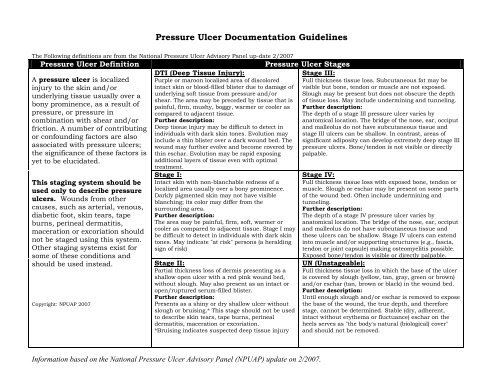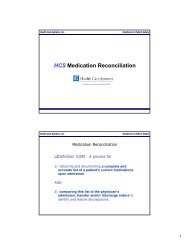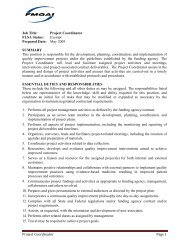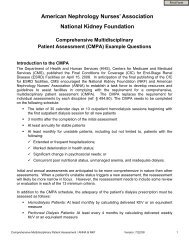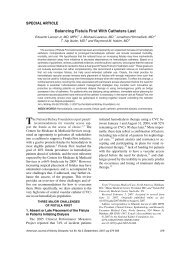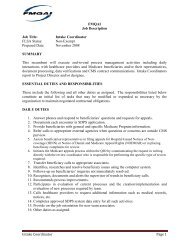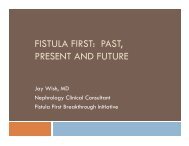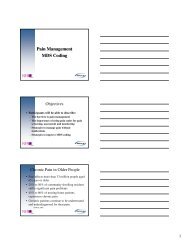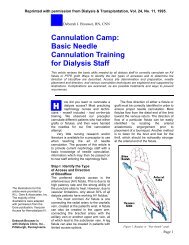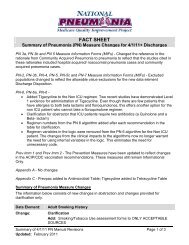Pressure Ulcer Documentation Guidelines - FMQAI
Pressure Ulcer Documentation Guidelines - FMQAI
Pressure Ulcer Documentation Guidelines - FMQAI
You also want an ePaper? Increase the reach of your titles
YUMPU automatically turns print PDFs into web optimized ePapers that Google loves.
<strong>Pressure</strong> <strong>Ulcer</strong> <strong>Documentation</strong> <strong>Guidelines</strong><br />
The Following definitions are from the National <strong>Pressure</strong> <strong>Ulcer</strong> Advisory Panel up-date 2/2007<br />
<strong>Pressure</strong> <strong>Ulcer</strong> Definition<br />
A pressure ulcer is localized<br />
injury to the skin and/or<br />
underlying tissue usually over a<br />
bony prominence, as a result of<br />
pressure, or pressure in<br />
combination with shear and/or<br />
friction. A number of contributing<br />
or confounding factors are also<br />
associated with pressure ulcers;<br />
the significance of these factors is<br />
yet to be elucidated.<br />
This staging system should be<br />
used only to describe pressure<br />
ulcers. Wounds from other<br />
causes, such as arterial, venous,<br />
diabetic foot, skin tears, tape<br />
burns, perineal dermatitis,<br />
maceration or excoriation should<br />
not be staged using this system.<br />
Other staging systems exist for<br />
some of these conditions and<br />
should be used instead.<br />
Copyright: NPUAP 2007<br />
DTI (Deep Tissue Injury):<br />
Purple or maroon localized area of discolored<br />
intact skin or blood-filled blister due to damage of<br />
underlying soft tissue from pressure and/or<br />
shear. The area may be preceded by tissue that is<br />
painful, firm, mushy, boggy, warmer or cooler as<br />
compared to adjacent tissue.<br />
Further description:<br />
Deep tissue injury may be difficult to detect in<br />
individuals with dark skin tones. Evolution may<br />
include a thin blister over a dark wound bed. The<br />
wound may further evolve and become covered by<br />
thin eschar. Evolution may be rapid exposing<br />
additional layers of tissue even with optimal<br />
treatment.<br />
Stage I:<br />
Intact skin with non-blanchable redness of a<br />
localized area usually over a bony prominence.<br />
Darkly pigmented skin may not have visible<br />
blanching; its color may differ from the<br />
surrounding area.<br />
Further description:<br />
The area may be painful, firm, soft, warmer or<br />
cooler as compared to adjacent tissue. Stage I may<br />
be difficult to detect in individuals with dark skin<br />
tones. May indicate "at risk" persons (a heralding<br />
sign of risk)<br />
Stage II:<br />
Partial thickness loss of dermis presenting as a<br />
shallow open ulcer with a red pink wound bed,<br />
without slough. May also present as an intact or<br />
open/ruptured serum-filled blister.<br />
Further description:<br />
Presents as a shiny or dry shallow ulcer without<br />
slough or bruising.* This stage should not be used<br />
to describe skin tears, tape burns, perineal<br />
dermatitis, maceration or excoriation.<br />
*Bruising indicates suspected deep tissue injury<br />
<strong>Pressure</strong> <strong>Ulcer</strong> Stages<br />
Stage III:<br />
Full thickness tissue loss. Subcutaneous fat may be<br />
visible but bone, tendon or muscle are not exposed.<br />
Slough may be present but does not obscure the depth<br />
of tissue loss. May include undermining and tunneling.<br />
Further description:<br />
The depth of a stage III pressure ulcer varies by<br />
anatomical location. The bridge of the nose, ear, occiput<br />
and malleolus do not have subcutaneous tissue and<br />
stage III ulcers can be shallow. In contrast, areas of<br />
significant adiposity can develop extremely deep stage III<br />
pressure ulcers. Bone/tendon is not visible or directly<br />
palpable.<br />
Stage IV:<br />
Full thickness tissue loss with exposed bone, tendon or<br />
muscle. Slough or eschar may be present on some parts<br />
of the wound bed. Often include undermining and<br />
tunneling.<br />
Further description:<br />
The depth of a stage IV pressure ulcer varies by<br />
anatomical location. The bridge of the nose, ear, occiput<br />
and malleolus do not have subcutaneous tissue and<br />
these ulcers can be shallow. Stage IV ulcers can extend<br />
into muscle and/or supporting structures (e.g., fascia,<br />
tendon or joint capsule) making osteomyelitis possible.<br />
Exposed bone/tendon is visible or directly palpable.<br />
UN (Unstageable):<br />
Full thickness tissue loss in which the base of the ulcer<br />
is covered by slough (yellow, tan, gray, green or brown)<br />
and/or eschar (tan, brown or black) in the wound bed.<br />
Further description:<br />
Until enough slough and/or eschar is removed to expose<br />
the base of the wound, the true depth, and therefore<br />
stage, cannot be determined. Stable (dry, adherent,<br />
intact without erythema or fluctuance) eschar on the<br />
heels serves as "the body's natural (biological) cover"<br />
and should not be removed.<br />
Information based on the National <strong>Pressure</strong> <strong>Ulcer</strong> Advisory Panel (NPUAP) update on 2/2007.
<strong>Pressure</strong> <strong>Ulcer</strong> <strong>Documentation</strong> <strong>Guidelines</strong><br />
When charting a description of a pressure ulcer, the following components should be a part of your weekly charting.<br />
1.<br />
2.<br />
3.<br />
4.<br />
5.<br />
6.<br />
7.<br />
LOCATION<br />
STAGE per NPUAP Definitions on previous page<br />
DIMENSIONS: Always measure length, width, and depth and document it in that order. Always recorded in centimeters.<br />
♦ Length: Longest head-to-toe measurement.<br />
♦ Width: Longest hip-to-hip measurement.<br />
♦ Depth: Is measured by gently inserting a pre-moistened cotton tipped applicator into the deepest part of the wound. The<br />
measurement from the tip of the applicator to the level of the skin surface is the depth. If too shallow to measure record as<br />
“superficial”.<br />
UNDERMINING/TUNNELING: Recorded in centimeters. Measurement done as if the resident is on a clock with the resident’s head at <br />
12 noon.<br />
♦ Undermining: Measure the extent of the undermining clockwise, then the deepest part of the undermining (i.e., 1.5cm from 2-7<br />
o’clock).<br />
♦ Sinus tracts/Tunneling: Measure the depth of the sinus tract/tunnel and give direction of the sinus tract/tunnel by the clock<br />
method (i.e., 3cm at 3 o’clock). If there is more than one sinus tract/tunnel, number each clockwise.<br />
WOUND BASE DESCRIPTION: describe the wound bed appearance. If the wound base has a mixture of these, use the percentage of its<br />
extent (i.e., the wound base is 75% granulation tissue with 25% slough tissue).<br />
♦ Granulation: Pink or beefy red tissue with a shiny, moist, granular appearance.<br />
♦ Necrotic Tissue: Gray to black and moist<br />
♦ Eschar: Gray to black and dry or leathery in appearance.<br />
♦ Slough: Yellow to white and may be stringy or thick and may appear as a layer over the wound bed.<br />
♦ Epithelial: New or pink shiny tissue that grows in from the edges or as islands on the wound surface.<br />
DRAINAGE:<br />
♦ Amount: Scant, moderate, or copious (small, medium, or heavy)<br />
♦ Color/Consistency: Serous, serosanguineous, purulent, or other.<br />
♦ Odor: If present or not<br />
WOUND EDGES: Describe area up to 4cm from edge of the wound. Measure in centimeters. Describe its characteristics (light pink, <br />
deep red, purple, macerated, calloused, etc.).<br />
8. ODOR: Present or not<br />
9. PAIN: Associated with the wound. Interventions<br />
10. PROGRESS: Improved, No Change, Stable, or Declined.<br />
Information based on the National <strong>Pressure</strong> <strong>Ulcer</strong> Advisory Panel (NPUAP) update on 2/2007.


